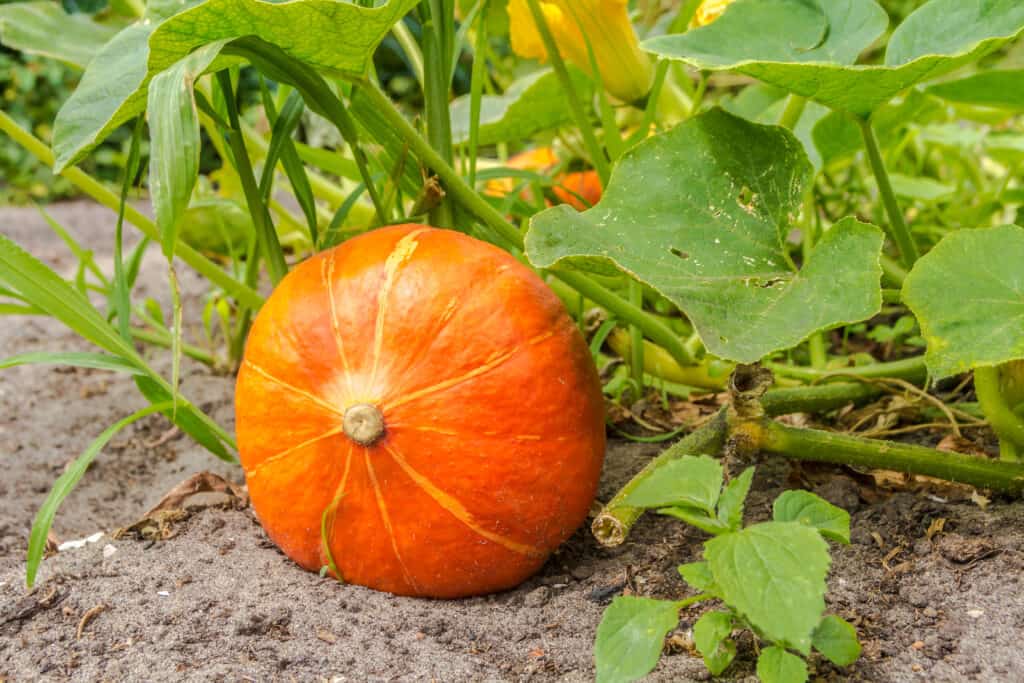Pumpkins are a warm-season annual that requires from 90 to 120 frost-free days to reach harvest. Grow pumpkins in the warmest, frost-free part of the year.
Sow pumpkin seed or set out transplants about 2 weeks after the last expected frost in spring. Sow or plant a successive crop 4 weeks later.
Sow pumpkin seeds or set transplants in raised mounds at least 1 foot across. Place a generous amount of aged compost or aged manure into each planting hill before planting. For an extra early harvest, start seeds in peat pots indoors 3 weeks before the last frost for planting out after the last frost.
Related articles:
- Five Ways to Cook Pumpkin
- How to Make Pumpkin Ice Cream
- Pumpkin Seed Starting Tips
- How to Harvest and Store Pumpkins
- How to Plant and Grow Pumpkins
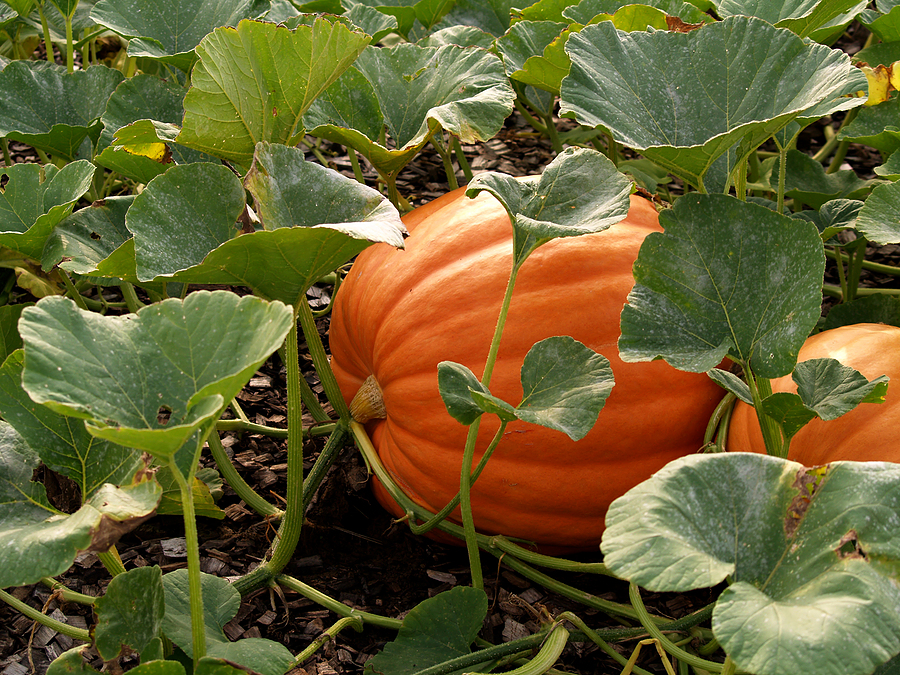
Here is your complete guide to growing pumpkins.
Pumpkin growing quick tips
- Sow pumpkins in the garden in spring when all danger of frost has passed and the soil temperature has reached 65°F (18°C) and night air temperatures are above 55°F (13°C). In cool-summer regions grow smaller varieties.
- Start pumpkins indoors 2 to 3 weeks before the average last frost date in spring; transplant them into the garden 2 to 3 weeks after the last frost.
Good Products for Growing Pumpkins at Amazon:
- Garden Safe Snail and Slug Bait
- Bonide Sulfur Fungicide
- Monterey BT Caterpillar Killer
- Neem Bliss 100-% Cold Pressed Neem Oil
Planting pumpkins
Plant pumpkins when night temperatures no longer fall below 55°F and the soil is at least 60°F (seeds will not germinate in cold soil–the optimal soil temperature is 70°F).
Prepare the planting site by digging a hole 18 inches wide and deep. Place 3 to 4 inches of aged compost or manure into the bottom of the hole and refill the hole with 3 parts soil and 1 part compost or manure.
Create a planting hill about 4 inches high. Space the hills about 3 to 4 feet apart for bush squash and 8 feet or more apart for vining plants. Set 6 to 8 seeds evenly spaced on each mound.
Plant several pumpkin plants or several seeds to ensure at least one is successful and survives pests and diseases. The pumpkin is a tender vegetable and will not germinate in cold soil; seedlings will be injured by frost. Plant after the last frost and allow a full warm growing season for pumpkins to reach maturity.
- Plant pumpkins in full sun; pumpkins will tolerate partial shade but full sun is preferable.
- Pumpkins grow best in loose, well-worked, well-drained soil rich in organic matter. Add aged compost to planting beds in advance of sowing.
- Pumpkins prefer a soil pH of 6.0 to 6.8.
- Plant pumpkins on a hill mounded 6 inches or more above the garden. The mound will collect solar heat which will enhance growth. A mound 36 or more inches across will support three plants.
- Work plenty of aged compost and aged manure or commercial organic planting mix into the hill before planting.
- Pumpkins require ample room for growth. Vining varieties sprawl and may require between 50 and 100 square feet of space. Bush varieties require less space than vining varieties.
- Pumpkin vines planted on a mound can be trained in an ever-widening circle around the mound.
- Pumpkins also can be planted in beds covered with black plastic sheeting. The black plastic will warm the soil. Cut a hole in the plastic to plant seeds or transplants.
Tools for Vegetable Gardeners at Amazon:
- A.M. Leonard Straight Rake with Ash Handle
- All-Steel Nursery Spade with D-Grip Handle
- 4-Tine Spading Digging Fork with D-Handle
- Digital Soil pH Meter Outdoors Greenhouse
- Earthwise Handheld Electric Fertilizer Spreader
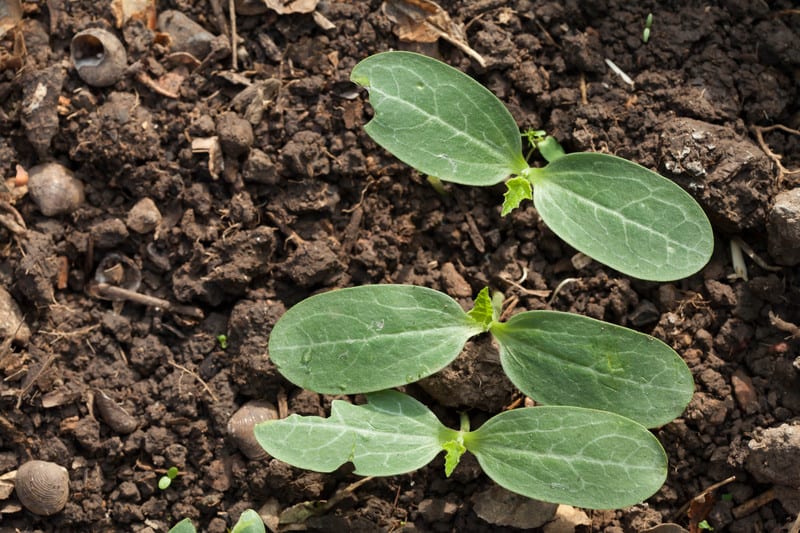
Starting pumpkins indoors
- Pumpkins can be started indoors 2 to 3 weeks before the average last frost date in spring for transplanting into the garden 2 to 3 weeks after the last frost.
- Start seeds in individual peat pots or biodegradable containers. The roots of pumpkin seedlings are very sensitive. Start seed indoors in peat pots then set individual pots and seedlings in the garden together at transplanting time.
- Sow seed 1 inch (2.5cm) deep.
- The seed will germinate in 5 to 10 days at 70°F (21°C).
- Pumpkin seed coats are hard. To speed germination soak seeds in warm water or 1 hour before planting. The long edges of seeds also can be lightly filed with a nail file; this will weaken the seed coat and speed germination.
- Grow seedlings indoors under grow lights of fluorescent lights. Keep the soil evenly moist.
- When transplanting seedlings to the garden make sure the rim of the peat pot is not exposed to the air or it will wick moisture away from the plant’s roots.
Starting pumpkins in the garden
Pumpkins will germinate in 7 to 14 days depending upon the variety. When plants are 3 inches tall thin to the two strongest seedlings (use scissors to thin rather than pulling plants up by the roots which can upend neighboring plants). Use cloches to protect cold-sensitive seedlings if frost threatens.
- Direct sow pumpkin seeds in the garden 2 to 3 weeks after the average last frost date when the soil temperature has reached 65°F (18°C) and night air temperatures stay above 55°F (13°C).
- The optimal soil temperature for starting pumpkins in the garden is 70°F (21°C) or warmer.
- Keep floating row covers handy to protect young plants from chilly night temperatures or unseasonal weather. Pumpkins are very sensitive to cold soil and frost.
- In cool-summer regions grow smaller, quick-maturing varieties.
- In warm-winter regions or very hot summer regions, plant pumpkins in late winter for harvest in late spring.
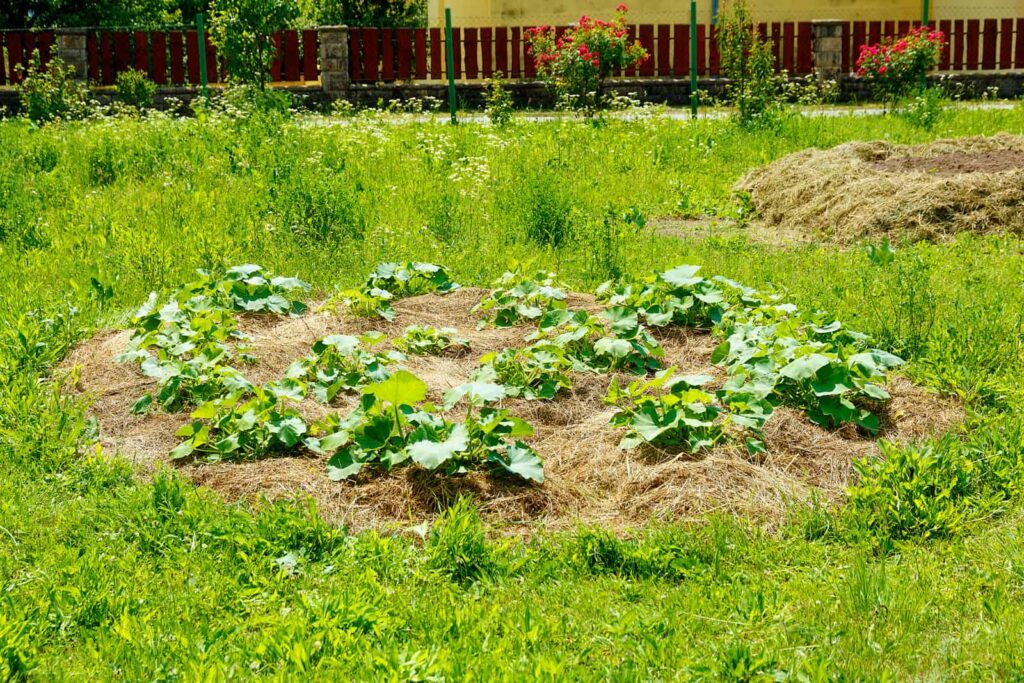
Planting and spacing pumpkins
Give pumpkins plenty of space. This will not only allow them to mature but also deter pests and diseases. Vining pumpkins require at least 50 to 100 square feet per hill; keep hills 5 to 6 feet apart and rows 10 to 15 feet apart. Semi-bush varieties: space hills 4 feet apart and rows 8 feet apart. Miniature varieties: space hills 3 feet apart and rows 6 to 8 feet apart. If the garden is tight, contain pumpkins by pinching out the growing tips after a vine has one or two fruits.
- Plant pumpkins on raised mounds 6 to 12 inches (15-30cm) high and at least 24 to 36 inches (61-91cm) across. Larger is better. At the top of the mound, you can remove an inch of soil to build up a rim around the edge of the mound creating a basin for watering.
- Space hills 6 to 8 feet (1.8-2.4m) apart.
- Sow pumpkin seeds 1 inch (2.5cm) deep.
- Sow 6 to 8 seeds on each hill.
- When seedlings are 2 to 3 inches (5-7cm) tall, thin to the 2 or 3 strongest seedlings. Cut off thinned seedlings at the soil level to avoid disturbing the roots of the remaining plants.
- Thinned seedlings should be spaced 18 to 36 inches (45-91cm) apart.
- Pumpkins growing in rows should be spaced 24 inches (61cm) apart and rows should be 6 to 10 feet (1.8-3m) apart.
- Grow 1 to 2 pumpkin plants per household member.
Protect pumpkins from cold
Floating row covers will protect squashes from dipping temperatures. If night temperatures fall below 65°F put the row covers in place. Row covers will also protect plants from early pests. When plants begin to flower (about three weeks after they have sprouted), remove the row covers to allow for pollination by bees and insects.
More tips at Pumpkin Seed Starting Tips.
Container growing pumpkins
- Pumpkins require a great amount of space and so they are not good candidates for container growing. However, you can grow a small, space-saving variety in a 10-gallon container. Train the vines to grow around the container.
- Keep the soil in containers evenly moist throughout the growing season.
- Feed plants compost tea or diluted fish emulsion every two weeks.
Pumpkin companion plants
- Plant pumpkins with corn. Avoid planting pumpkins with potatoes or squash.
- Plant flowering herbs such as dill or bee balm near pumpkins to attract bees and other pollinators.
Pumpkin pollination
Pumpkin plants have separate male and female flowers on the same plant. Bees or insects must transfer the pollen from the male flowers to the female. Avoid using insecticides in the garden when pollinators are active. If you must use an insecticide apply in the late afternoon or early evening when the blossoms have closed for the day; it is unlikely pollinators will be active at this time.
Pumpkin plants easily cross-pollinate. If you grow more than one type of squash in your garden, hand-pollination may be the best way to prevent cross-breeding. You can transfer pollen from the male stamen to the female pistil using a small brush or pick off the male flower and run the stamen against the female flower. Female flowers often blossom before male flowers appear. (Female flowers have a tiny fruit at their base.) If female flowers are not pollinated, they will dry up and fall off. Because squash plants are prolific bloomers, soon male flowers will appear to pollinate later female blossoms. As well, squash plants will sometimes abort small fruits when there is a heavy fruit set. This is a self-pruning process.
- The first flowers to appear on the pumpkin plant will be male flowers that do not bear fruit. Male flowers appear about a week before female flowers. They attract bees and other pollinators.
- Female flowers appear on the plant after male flowers. Female flowers will bear an immature pumpkin beneath the blossom at the stem end of the flower. Female flowers must be pollinated by bees that first visit male flowers.
- Plant flowering herbs such as dill, bee balm, and marigolds close to pumpkins to attract bees and other pollinators.
- If pollinators are in short supply, pumpkins can be hand pollinated. Use a small artist’s bristle brush to collect pollen from a male flower then brush the pollen onto the pistil at the center of the female flower.
- Pumpkin blossoms are usually open in the morning and then close in the afternoon during the warmest of the day.
Watering pumpkins
Water pumpkin seedlings well, and keep the soil moist throughout the season; the roots need regular moisture. If plants look wilted before eleven o’clock in the morning, they need water. (Dig down in the soil; if the soil is dry at four inches down–water. If the soil is moist at three inches down, watering is good.) To avoid transmitting diseases, water at the base of each plant and keep the foliage dry. Leaf and fruit diseases are easily transmitted via wet foliage. Avoid handling plants when they are wet. It is not unusual for squash to wilt slightly on hot days.
- Pumpkins require regular, even water to keep vines and fruiting growing without interruption. Give pumpkins 1 to 1½ inches of water each week (1 inch/2.5cm of water equals about 16 gallons/60.5 liters).
- Do not let the soil dry out. Slow, deep watering is best.
- Water at the base of plants using drip irrigation of a soaker hose. Avoid wetting leaves; wet leaves are susceptible to fungal diseases.
Feeding pumpkins
Squashes are heavy feeders. Add plenty of aged compost or manure to the planting bed in advance of sowing. Before you plant, place aged compost or manure at the bottom of each planting hole and throw in a buffer inch or two of native soil. This will get plants off to a strong start. Apply compost tea or manure tea at transplanting or two weeks after seedlings emerge. Feed again with compost tea in three weeks or when the first flowers appear. When the first fruits set, water each plant with compost tea or side-dress each plant with a shovel full of compost. If leaves are pale, give plants a dose of fish emulsion. But be careful not to give squashes too much nitrogen; nitrogen will increase leafy growth but cut fruit yield.
- Add aged compost and manure or commercial organic planting mix to the planting area before planting.
- Feed pumpkins an organic fertilizer high in phosphorus once plants are established; a 5-10-10 formula is good.
- Side dress pumpkins with compost or manure tea or a dilute fish emulsion solution every two weeks during the growing season.

Caring for pumpkins
- Keep the planting area weed-free. Weeds compete for soil moisture and nutrients and harbor pests and diseases which can attack pumpkins.
- Allow just 2 or 3 fruits to mature on each plant.
- Set developing fruits on tiles, sheets of plastic, or wooden shingles so that they do not develop rot sitting on wet soil.
- Turn pumpkins as they develop to encourage an even shape. A pumpkin that is not turned may have a flattened side at harvest time.
- To grow pumpkins for large size, choose two or three fruits early for development; remove the remaining fruit and vines.
- When pumpkins have formed on a plant, pinch or snip off the fuzzy end of each vine. This will stop vine growth and the plant will put its energy into fruit growth. Vines without fruit can be pruned back to about 2 feet long.
- Remove new female flowers from vines once two or three fruits are growing on a plant.
Mulching pumpkins
To avoid rot, put 6 inches of straw, hay, or dry leaves under the fruit. Mulch when vines begin to lengthen. This will slow weed growth. Weeds compete with crops for water and nutrients. If the mulch gets wet, set a board or shingle under each fruit. Early in the season, black plastic can be used to mulch squashes. Black plastic helps warm the soil earlier and keeps it warm; this, in turn, can speed up the growth of squashes.
Pumpkin pests
Cucumber beetles, squash bugs, and squash vine borers will attack pumpkins. These pests must be controlled to successfully grow pumpkins and other squashes. Place floating row covers over young pumpkin plants until they start to bloom. This will exclude attacking insects until plants are strong enough to withstand pest damage.
- Pumpkins can be attacked by squash borers and cucumber beetles.
- Squash vine borers will drill a small hole in the stem. Unexplained wilting may indicate the presence of borers. To remove a borer, slit the stem lengthwise, remove the borer, and crush it. Cover the slit stem with soil to encourage root development from that point.
- Spotted and striped cucumber beetles chew holes in leaves and can spread bacterial wilt and other diseases. Handpick and destroy cucumber beetles or spray with neem or pyrethrum.
- Squash borers or bacterial wilt can cause squash plants to suddenly wilt and die just as they begin to produce.
Pumpkin diseases
- Pumpkins are susceptible to bacterial wilt, mosaic virus, and mildew. Plant disease-resistant varieties.
- Keep the garden clean and free of debris that diseases and pests may harbor. Water at the base of plants to keep water off the foliage, and do not handle plants when they are wet to avoid the spread of fungal spores.
- Remove and destroy infected plants before they spread the disease to healthy plants.
- Bacterial wilt is spread by cucumber beetles. Bacterial wilt will cause pumpkin plants to suddenly wilt and die just as they start to produce pumpkins. Control the beetles to control the spread of disease.
- Mosaic virus can cause squash plants to become mottled yellow and stunted. The mosaic virus is spread by aphids. Control aphids and remove affected plants.
- Powdery mildew, a fungus disease, will cause leaves to turn a gray-white color late in the season. Proper spacing and increased air circulation will help reduce this problem.
Harvesting pumpkins
Pumpkins require 100 or more days to reach harvest. Pick pumpkins when they are a deep, solid color–orange for most varieties–and the rind is hard. Pick pumpkins before the first hard frost. Use pruning shears to cut pumpkins from the vine and leave a 3 to 4-inch stem attached to the fruit. Pumpkins without stems do not keep well.
Harvest pumpkins when the weather is dry. Harvest pumpkins before the first frost. Dry pumpkins in the sun until stems shrivel and turn gray; this will take about a week. Store winter squash in a cool, dry place with temperatures of 45° to 50°F and with 65 to 70 percent humidity.
- Pumpkins will be ready for harvest 95 to 120 days after sowing depending on the variety.
- Pick pumpkins when they are deeply colored–deep orange or golden white–and stems and vines have dried and turned brown.
- The rind should be hard, not easily penetrated by a fingernail.
- Thump maturing pumpkins; a ripe pumpkin will sound hollow when thumped.
- As pumpkins mature, remove leaves that shade the fruit to allow for maximum sun exposure.
- As pumpkins near harvest, vines may begin to yellow and shrivel away.
- Use pruning shears to cut the vine; leave 2 to 4 inches (5-10cm) of stem attached to the pumpkin so that the fruit does not readily dry out or decay.
- Harvest pumpkins before the first freeze or they will turn soft.
- Seeds saved from heirloom or open-pollinated pumpkins can be saved for up to 6 years for replanting.
Storing and preserving pumpkins
- Cure pumpkins in direct sun at 75° to 80°F (24-26°C) for 2 weeks before storing.
- Store pumpkins at 50° to 55°F (10-13°C), in a dry, well-ventilated place.
- Do not refrigerate pumpkins.
- Cured pumpkins can be stored for 3 to 6 months.
- Pumpkins in storage can shrink as much as 20 percent in weight but will still be suitable for cooking.
- Pumpkin can be pureed and frozen for up to 6 months. Pumpkins also can be frozen or canned.
More tips: How to Harvest and Store Pumpkins.
Pumpkin size: cooking or carving
Small pumpkins are best for cooking. They will be sweet and delicious, perfect for pie fillings, bread, muffins, and soups.
Intermediate and large pumpkins are usually not very tasty to eat and are best suited for Jack-o’-lanterns. And those huge pumpkins you see at the county fair and pumpkin growing competitions, are best for just that—fairs and competitions.
The orange, round, ribbed vegetable we call the pumpkin is one of the hard-skinned squashes that fall under the general term winter squash. A winter squash seed goes into the soil at about the same time as the summer or soft-skinned squash seed (think zucchini), but after harvest, the winter squash’s hard shell allows it to be stored for use during the winter.
So how is a pumpkin different from other winter squashes—such as the Hubbard or acorn squash? Well, there is no precise botanical difference. The difference is simply in the shape and coloration that has come to be associated with Halloween.
Choosing a pumpkin to grow
If you are growing a pumpkin for pie, muffins, or soup, look for a small 4-6 pound pumpkin. Recommended varieties are ‘Early Sweet Sugar’, ‘Luxury’, ‘Spookie’, and ‘Sugar Pie’.
If you are planning to carve your pumpkin into a Jack-o’-lantern, good choices are ‘Cinderella’, ‘Spirit’, and the aptly named ‘Jack-o’-lantern’. These varieties are two to three times larger than the pumpkins you choose for cooking.
Recipe for pumpkin soup:
Place 2 pounds of fresh sugar pumpkin in 3 cups of scalded milk; knead together and add 1 tablespoon of butter and 1 tablespoon of flour. Add 2 tablespoons of brown sugar; season with salt and pepper or ginger and cinnamon; add ½ cup of finely julienned ham. Heat (do not boil) and serve.
A half-cup of fresh mashed pumpkin contains 24 calories, just a trace of fat, 6 grams of carbohydrates, and a whopping 26908 international units of Vitamin A.
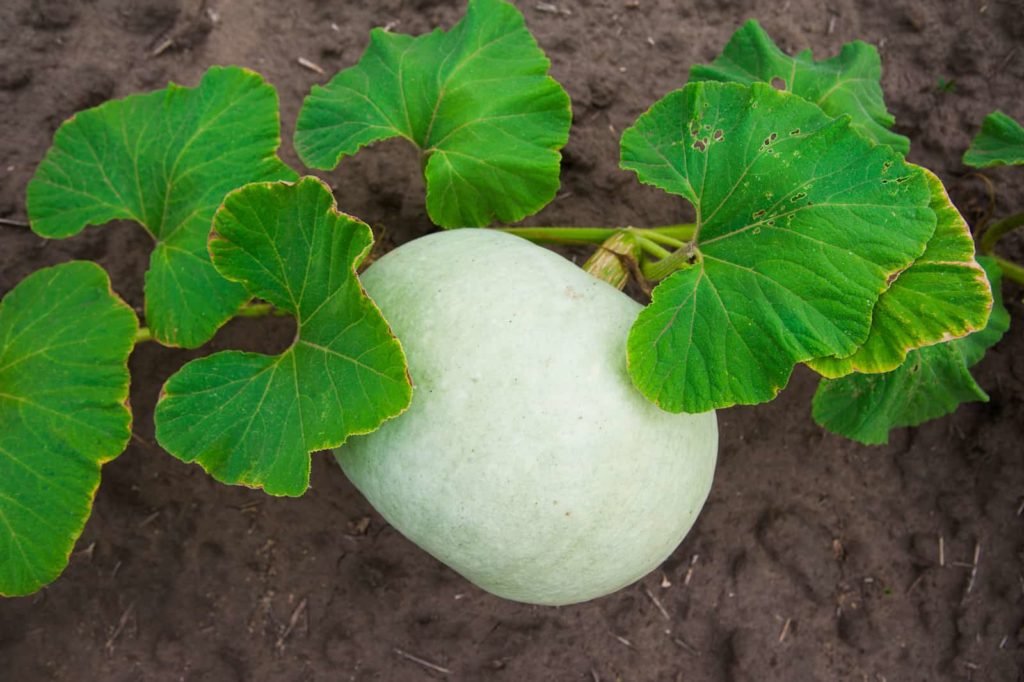
Pumpkin varieties to grow
Here is a list of best bet, easy-to-grow pumpkins divided into size categories: (1) small pumpkins (2 to 5 pounds); (2) intermediate-size pumpkins (8 to 15 pounds); (3) large pumpkins (15 to 25 pounds); (4) jumbo pumpkins (50 to 100 pounds and larger).
Small pumpkins (2 to 5 pounds):
- Baby Bear. 105 days. AAS. Half the size of a normal pumpkin. Fine-grained flesh, excellent for pies. Deep orange fruit 5 to 6 inches wide and 3½ to 4 inches tall. Weighs 1½ to 2 pounds. The strong stem is easy to grip. Seeds are semi-hull less for seed toasting. Blight and frost tolerant. Cross between New England Pie and a small naked seed pumpkin. Great for home garden
- Baby Pam. 100 days. Deep orange flesh; is good for pies. Uniform size: 5 inches tall by 5½ in diameter. Smooth skin; indistinct ribs. Tight, secure stem. Vigorous 10 to 12-foot vines. Heavy yield. Also called “Oz.”
- Small Sugar (also called New England Pie). 100-105 days. Best tasting pie pumpkin; excellent flavor. Deep-orange flesh; 5 to 8 pounds. A convenient size for kitchen use. For baking and canning. Pre-Civil War heirloom. Open-pollinated.
- Winter Luxury. 85-100 days. Sweet, juicy, and tender. Very good keeper for winter use. Moderately small fruit 9 to 10 inches in diameter 6 to 7 inches deep; weighs 7 to 8 pounds. Nearly globular and narrowly ribbed; yellow-orange skin, uniform fine, light-gray cork-like netting; pale orange flesh. Introduced in 1893.
Intermediate pumpkins (8 to 15 pounds):
- Autumn Gold. 100 days. AAS. Meaty, deep-orange flesh for pies. Medium-sized fruit weighs 10 to 15 pounds, round to rectangular in shape, and nicely ribbed; rich orange skin matures to golden when mature. Contains the “precious yellow gene”: all fruit is deep yellow; no green pumpkins at harvest. Vigorous vines produce 3 or more fruit. Hybrid.
- Bushkin. 95 days. Thick, delicious light-yellow flesh, keeps well. Use for pies, seed snacks, and carving. Bright golden orange pumpkins weigh 8 to 10 pounds; 1 to 3 fruits per plant. Compact, bush-type vine for a large container or small garden, vine spreads only 5 to 6 feet. Open-pollinated.
- Jack O’Lantern. 75-115 days. Carving pumpkin. Sweet, fine-grained, pale orange flesh; good for cooking and stores well. Smooth, yellow-orange skin; irregular shape, round to oblong, shallow ribs, 9 to 10 inches tall, 7 to 10 inches in diameter; weighs 10 to 18 pounds.
- Spirit. 95 days. AAS. Thick, meaty flesh for pies and custards. Round fruit, 12 inches in diameter, moderately ribbed, weighs 10 to 15 pounds; bright orange skin. Semi-bush, the short-vined plant spreads to 5 feet. Early-maturing. Heavy yield. Hybrid.
Large pumpkin (15 to 25 pounds):
- Big Tom. 120 days. Large orange pumpkin, 11 inches tall, 13 inches wide, flat on both ends; orange rind, orange-yellow flesh, weighs 18 pounds or more pounds.
- Cinderella (also called Rouge Vif D’Etampes). 84-100 days. Sweet, yellow-orange flesh. Globe-shaped pumpkin, smooth, bright-orange skin, 10 inches in diameter, weighs 20 to 25 pounds. The bush-type vine needs 6 square feet for growing. Does not keep as well as other vine types. Open-pollinated.
- Connecticut Field. 100-120 days. Coarse, somewhat granular, deep-yellow flesh with slight sweetness; best for canning and jack-o’ lanterns. Large, globe-shaped, flattened at ends 10 to 18 inches tall, 12 to 15 inches in diameter, weighs 15 to 25 pounds. Slightly ribbed, bright yellow-orange rind. Native American origin. Open-pollinated.
- Ghost Rider. 110-115 days. Yellow-orange flesh for processing and for jack o’lantern carving. Round fruit with dark orange, ridged rind, and long dark green to a black stem; weighs 15 to 30 pounds.
- Happy Jack. 105-110 days. Best for baking and processing. Symmetrical, dark orange fruit with strong dark green stems; weighs 16 to 22 pounds. Large vigorous vines.
- Howden Field. 105-115 days. Solid, thick flesh stores well. Large, symmetrical, ridged, rich-orange skin, weighs 20 to 25 pounds. Large spreading vines. Open-pollinated.
- Jumpin’ Jack. 110-120 days. Good eating quality. Deep orange flesh. Large symmetrical, ridged, dark-orange skin, solid black-green stem, ranges from 20 to 60 pounds. Large spreading vines.
- Pankow’s Field. 100-120 days. Excellent for Jack o’lanterns. Large, round, symmetrical fruit, weighs 20 to 30 pounds, smooth skin. Variable skin color. Thick sturdy stem. Heavy yield.
Jumbo pumpkins (50-100 pounds):
- Dill’s Atlantic Giant. 110-125 days. Huge, round, pinkish-orange fruit to 10 feet in diameter and up to 800 pounds; 200 to 300-pound fruit common on vines with one fruit; 50 to 100-pound fruits common on plants with multiple fruits. Open-pollinated.
- Big Max. 110-120 days. Exhibition-type pumpkin is also good for pies and canning. Large, nearly round fruit, 17 to 18 inches in diameter; fruits average 100 pounds. Slightly rough, red-orange skin 3 to 4 inches thick.
- Big Moon. 110-120 days. Large fruits average 100 pounds, some to 200 pounds. Slightly round to 40 inches in diameter, heavily ribbed, medium orange skin, thick light-orange flesh, large crown seeds. Vigorous vine.
- Mammoth Gold. 105-120 days. Novelty and pie pumpkin with coarse pale yellow-orange flesh. Irregular globe shape, smooth mottled pinkish-golden-orange skin, faintly ribbed, 18 to 24 inches in diameter, weighs 40 to 60 pounds, some over 100 pounds.
- Prizewinner. 120 days. Good flavor, and orange flesh. Large, uniform, roundish fruit with smooth, glossy, bright reddish-orange skin. Easily average 200 pounds. Vigorous vine 30 to 40 feet in length. Easy to grow without special care. Hybrid.
More pumpkin varieties to grow
- Extra-large (50 to 100 pounds): ‘Atlantic Giant’ (125 days); ‘Big Max’ (120 days); ‘Big Moon’ (120 days); ‘Mammoth King’ (120 days); ‘Prizewinner’ (120 days); ‘The Great Pumpkin’ (120 days).
- Large (15 to 25 pounds, 100 days): ‘Aspen’ (93 days); ‘Connecticut Field’ (120 days); ‘Ghost Rider’ (115 days); ‘Half Moon’ (115 days); ‘Howden’ (115 days); ‘Pankow’s Field’ (120 days); ‘Pro Gold’ (95 days); ‘Tallman’ (110 days); ‘Wizard’ (115 days).
- Intermediate (8 to 15 pounds): ‘Autumn Gold’ (90 days); ‘Big Autumn’ (100 days); ‘Jack O’Lantern’ (115 days); ‘Oz’ (105 days); ‘Small Sugar Pie’ (110 days); ‘Tom Fox’ (110 days); ‘Trick or Treat’ (105 days).
- Small (4 to 6 pounds): ‘Bush Spirit’ (100 days); ‘Frosty’ (95 days), ‘Wee-B-Little’ (90 days).
- Others: ‘Baby Bear’ (105 days); ‘Baby Boo’ (95 days); ‘Buckskin’ (110 days); ‘Casper’ (80 days); ‘Cushaw, Green Striped’ (110 days); ‘Gremlin’ (100 days); ‘Japanese Pumpkin’ (110 days); ‘Jarrahdale’ (110 days); ‘Lady Godiva’ (110 days); ‘Little Gem’ (110 days); ‘Little Lantern’ (100 days); ‘Long Cheese’ (120 days); ‘Lumina’ (110 days); ‘Munchkin’ (110 days); ‘Rouge D’Etampes’ (95-160 days); ‘Sweetie Pie’ (110 days).
Favorite pumpkins to grow
- ‘Jack Be Little’ is a miniature pumpkin for table decoration.
- ‘Wee-B-Little’ is an All-America Selection, the size of a baseball.
- ‘Autumn Gold’ is ideal for carving a Jack-o-Lantern.
- ‘Sugar Treat’ and ‘Baby Bear’ are excellent for pies.
- ‘Atlantic Giant’ and ‘Big Max’ grow to 200 pounds by the time of the county fair.
The legend of Jack-o’-Lantern
Cut off the top of your pumpkin, scoop out the seed, carve a face in the flesh, place a candle inside, and replace the top. That is the story of Jack-o’-Lantern. Well, not quite.

Actually, Jack—so the legend goes—was rather lazy though crafty farmer. He made his way through life not by farming but by cheating and stealing from his neighbors. When his neighbors weren’t after him, the Devil was.
One time, Jack tricked the Devil into climbing up a tree. Then Jack cleverly placed crosses around the tree trunk so that the Devil had no way to get down. Jack was amused but the Devil wasn’t.
The Devil bargained with Jack. “If you let me down, I promise I will never take your Soul,” the Devil told Jack. Jack agreed. He knew he had shrewdly found a way to never spend a day in Hell.
After Jack died, he approached the Pearly Gates of Heaven but was turned away because he had spent most of his life cheating and stealing from his neighbors. But Jack was barred from Hell as well. The Devil had promised to never take his Soul. He had nowhere to go.
“How will I find my way?” Jack asked. “I am in utter darkness.”
The Devil mocked Jack. He threw him an ember from the flames of Hell that would never burn out. “Find your own way,” the Devil said.
Jack carved out a pumpkin—a face with two eyes–and placed the ember inside.
Jack has endlessly wandered the Earth ever since looking without hope for a place to rest.
About pumpkins
The pumpkin is said to have gotten its name from the old French word for melon pompon which got its name from the Green word for melon pepon. In France, the pumpkin is used mostly for making soups (soupe au poitron).
- Pumpkins are tender squash-like annuals with smooth rinds scored with vertical grooves.
- Fruits can range in size from a few ounces to hundreds of pounds and in color from deep orange to white. Some heirloom varieties can be swirled multi-colored.
- Large, green leaves grow on branching vines that can reach 20 feet long.
- Large male and female flowers grow on the same vine.
- The name pumpkin is also given to other hard, orange squashes and gourds.
- Botanical name: Cucurbita maxima, Cucurbita moschata, Cucurbita pepo
- Origin: Tropical America
More tips:
How to Harvest and Store Pumpkins
Squash articles at Harvest to Table:
How to Grow Summer and Winter Squash
How to Plant and Grow Pumpkins
How to Harvest and Store Summer Squash
How to Harvest, Cure, and Store Winter Squash
How to Harvest and Store Pumpkins
Eight Ways to Cook and Serve Summer Squash
Seven Ways to Cook and Serve Winter Squash
How to Make Creamy Pumpkin Soup
How to Cook and Serve Squash Blossoms
Squash Growing Problems: Troubleshooting
Squash Vine Borer Organic Pest Control
Squash Bug Organic Pest Control
Corn, Beans, and Squash: The Three Sisters
Garden Planning Books at Amazon:
- Vegetable Garden Grower’s Guide
- Tomato Grower’s Answer Book
- Vegetable Garden Almanac & Planner
- Kitchen Garden Grower’s Guide Vegetable Encyclopedia
More how to grow articles:
Learn how to plant, grow, and harvest your favorite vegetables. Click below for all you need to know.
- Artichoke
- Arugula
- Asparagus
- Beans, Snap
- Beets
- Broad Beans
- Broccoli
- Brussels Sprouts
- Cabbage
- Cantaloupe — Melons
- Cardoon
- Carrots
- Cauliflower
- Celeriac
- Celery
- Chard
- Chayote Squash
- Chickpeas
- Chicory
- Chinese Cabbage
- Collards
- Corn Salad
- Corn, Sweet
- Cresses
- Cucumbers
- Eggplant
- Endive and Escarole
- Fava Beans
- Florence Fennel
- Garbanzo Beans
- Garlic
- Horseradish
- Jerusalem Artichoke
- Kale
- Kohlrabi
- Leeks
- Lettuce
- Lima Beans
- Melons
- Mizuna
- Mustard Greens
- New Zealand Spinach
- Okra
- Onions
- Parsnips
- Peanuts
- Peas
- Peppers
- Potatoes
- Pumpkins
- Radicchio
- Radishes
- Rhubarb
- Rutabaga
- Salsify
- Shallots
- Sorrel
- Southern Peas
- Soybeans
- Spinach
- Squash, Summer
- Squash, Winter
- Sunchokes
- Sweet Potato
- Swiss Chard
- Taro
- Tomatillo
- Tomatoes
- Turnips
- Watermelon
- Zucchini

